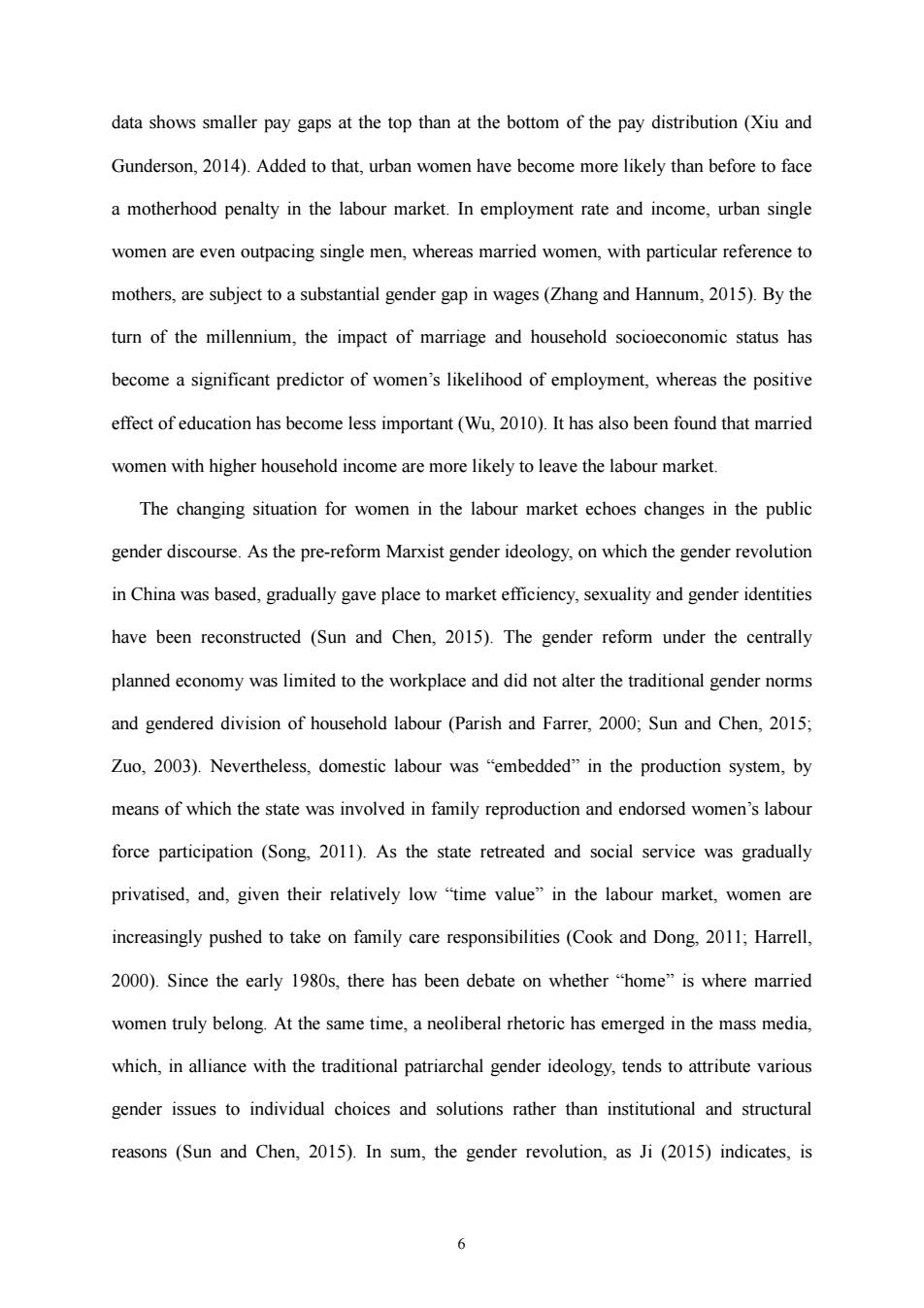正在加载图片...

data shows smaller pay gaps at the top than at the bottom of the pay distribution (Xiu and Gunderson,2014).Added to that,urban women have become more likely than before to face a motherhood penalty in the labour market.In employment rate and income,urban single women are even outpacing single men,whereas married women,with particular reference to mothers,are subject to a substantial gender gap in wages(Zhang and Hannum,2015).By the turn of the millennium,the impact of marriage and household socioeconomic status has become a significant predictor of women's likelihood of employment,whereas the positive effect of education has become less important(Wu,2010).It has also been found that married women with higher household income are more likely to leave the labour market. The changing situation for women in the labour market echoes changes in the public gender discourse.As the pre-reform Marxist gender ideology,on which the gender revolution in China was based,gradually gave place to market efficiency,sexuality and gender identities have been reconstructed (Sun and Chen,2015).The gender reform under the centrally planned economy was limited to the workplace and did not alter the traditional gender norms and gendered division of household labour(Parish and Farrer,2000;Sun and Chen,2015; Zuo,2003).Nevertheless,domestic labour was "embedded"in the production system,by means of which the state was involved in family reproduction and endorsed women's labour force participation (Song,2011).As the state retreated and social service was gradually privatised,and,given their relatively low "time value"in the labour market,women are increasingly pushed to take on family care responsibilities (Cook and Dong,2011;Harrell, 2000).Since the early 1980s,there has been debate on whether "home"is where married women truly belong.At the same time,a neoliberal rhetoric has emerged in the mass media, which,in alliance with the traditional patriarchal gender ideology,tends to attribute various gender issues to individual choices and solutions rather than institutional and structural reasons (Sun and Chen,2015).In sum,the gender revolution,as Ji (2015)indicates,is 66 data shows smaller pay gaps at the top than at the bottom of the pay distribution (Xiu and Gunderson, 2014). Added to that, urban women have become more likely than before to face a motherhood penalty in the labour market. In employment rate and income, urban single women are even outpacing single men, whereas married women, with particular reference to mothers, are subject to a substantial gender gap in wages (Zhang and Hannum, 2015). By the turn of the millennium, the impact of marriage and household socioeconomic status has become a significant predictor of women’s likelihood of employment, whereas the positive effect of education has become less important (Wu, 2010). It has also been found that married women with higher household income are more likely to leave the labour market. The changing situation for women in the labour market echoes changes in the public gender discourse. As the pre-reform Marxist gender ideology, on which the gender revolution in China was based, gradually gave place to market efficiency, sexuality and gender identities have been reconstructed (Sun and Chen, 2015). The gender reform under the centrally planned economy was limited to the workplace and did not alter the traditional gender norms and gendered division of household labour (Parish and Farrer, 2000; Sun and Chen, 2015; Zuo, 2003). Nevertheless, domestic labour was “embedded” in the production system, by means of which the state was involved in family reproduction and endorsed women’s labour force participation (Song, 2011). As the state retreated and social service was gradually privatised, and, given their relatively low “time value” in the labour market, women are increasingly pushed to take on family care responsibilities (Cook and Dong, 2011; Harrell, 2000). Since the early 1980s, there has been debate on whether “home” is where married women truly belong. At the same time, a neoliberal rhetoric has emerged in the mass media, which, in alliance with the traditional patriarchal gender ideology, tends to attribute various gender issues to individual choices and solutions rather than institutional and structural reasons (Sun and Chen, 2015). In sum, the gender revolution, as Ji (2015) indicates, is